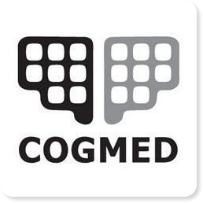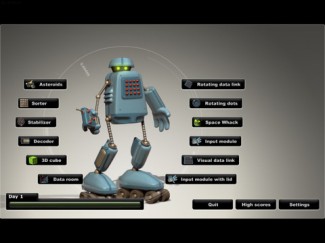Sue’s Focus Travels
LQ: 7.95
Recommended Age: 4+
Skills Used: Focus, Time Management, Mathematics, Writing

Recalling and retaining information in our mind while working.
 At its core, Cogmed Working Memory Training is designed to improve Working Memory capacity. It does so through a series of 12 challenging games that are designed to improve both verbal or visuospatial Working Memory. The 25 prescribed, home-based, computerized training sessions target different aspects of Working Memory and can be modified by the Cogmed coach to meet each client’s needs. The intensity and duration of the training helps to ensure that real world, generalizable gains are made after completion. In general, there is a standardized approach to the training, based upon each individual's age. However, a Cogmed coach can make adjustments based on specific needs.
At its core, Cogmed Working Memory Training is designed to improve Working Memory capacity. It does so through a series of 12 challenging games that are designed to improve both verbal or visuospatial Working Memory. The 25 prescribed, home-based, computerized training sessions target different aspects of Working Memory and can be modified by the Cogmed coach to meet each client’s needs. The intensity and duration of the training helps to ensure that real world, generalizable gains are made after completion. In general, there is a standardized approach to the training, based upon each individual's age. However, a Cogmed coach can make adjustments based on specific needs.
Cogmed Working Memory Training works by directly practicing and exercising Working Memory capacities. By directly improving memory, it enhances a variety of academic and executive functioning skills. Cogmed Working Memory Training is designed to actually change the structure of the brain, meaning the benefits that occur must be maintained, and should be generalized to a variety of real-world skills.
One of the more impressive features of Cogmed Working Memory Training is the level and sophistication of the feedback parents receive about their children’s progress. A series of graphs and charts that document daily efforts and overall gains are available and interpreted by the Cogmed coaches. In addition, there is an extended training program over the course of the year following the initial Cogmed training that is recommended to help consolidate gains.
Getting started and then maintaining attention and effort to tasks.

Working Memory difficulties are one of the core concerns in children who are diagnosed with Attention Deficit Hyperactivity Disorders (ADHD). Individuals who have difficulties with Working Memory may be unable to hold information in mind, which can lead to easy distraction. When an individual seems to forget directions quickly or can only remember a small number of items at any one time, focusing and sustained attention becomes difficult. Individuals who struggle to remain concentrated and attentive during prolonged tasks -- such as listening to a lecture or taking notes in class -- often lose focus because they cannot hold enough information in mind, or hold that information long enough for them to be able to tend to the task effectively. Thusly, an improvement in Working Memory leads to an improvement in Focus.
Improving Working Memory skills can have a direct impact upon a number of specific reading tasks, and have been demonstrated to improve the capacity to sound out words by allowing a child to keep letter sounds (phonemes) in mind while forming a word and remembering the shapes of letters and words.
Working Memory helps a child to recall the meaning of a word learned in the past, and to use it in the context of a written or spoken sentence. In addition, Working Memory plays an enormous role in reading comprehension, and is used for recalling what one has read and when meaning is taken from sentences and paragraphs. Reading comprehension requires that individuals be able to keep in mind what they have read earlier in a sentence or paragraph and combine that with newer information to have a full understanding of the content.
Cogmed Working Memory Training can improve visuo-spatial working memory skills that directly lead to gains in mathematical skills. Working Memory plays an important role in being able to hold information in mind while doing math word-problems or mental arithmetic. This is particularly true for any math word-problem in which a paper and pencil computation isn't an option. In addition, boosting Working Memory skills makes it easier to recall math facts and equations, and makes it easier to hold information such as multiplication tables in mind, so that doing complex mathematical problems requires less additional processing of information. Some children may know their math facts when drilled in a systematic way, but are unable to hold this information in mind (with Working Memory) when completing a complex calculation.
So you've finished your intensive Working Memory training, but now its time to transfer those skills into real-world application. Check out our recommended activities below to see how you can expand the benefits of Cogmed Working Memory Training by putting those skills to work. If you have a recommendation of your own to share, please, feel free comment at the bottom of the page.
 Cogmed Working Memory Training is designed to directly affect how the brain functions in order to improve Working Memory skills. Therefore, the most important strategy in making it successful is to encourage and support your child to put in full effort and intensity during the training itself. Just like going to the gym, consistency, effort, and challenging oneself leads to the largest gains and improvements. In addition, because Working Memory skills are practiced on a routine basis in the environment, your child can experience additional opportunities to practice and enhance their Working Memory skills. Every time your child needs to follow a set of complicated directions, figure out a math problem, or comprehend some casual reading, take the chance to highlight the way the use of Working memory impacts the task.
Cogmed Working Memory Training is designed to directly affect how the brain functions in order to improve Working Memory skills. Therefore, the most important strategy in making it successful is to encourage and support your child to put in full effort and intensity during the training itself. Just like going to the gym, consistency, effort, and challenging oneself leads to the largest gains and improvements. In addition, because Working Memory skills are practiced on a routine basis in the environment, your child can experience additional opportunities to practice and enhance their Working Memory skills. Every time your child needs to follow a set of complicated directions, figure out a math problem, or comprehend some casual reading, take the chance to highlight the way the use of Working memory impacts the task.
To support and enhance the effects of Cogmed Working Memory Training, individuals can apply a number of other strategies, and while many of these approaches don't necessarily help with acquiring improved working memory capacities, they do help support, practice and maintain memory.
One simple strategy for improving the ability to follow directions involves chunking a group of actions into a single action. For example, teaching a child to envelope related tasks together under one larger tasks can be helpful (for example, brushing teeth and washing up can be thought of as part of the "bedtime routine"). Just know that repetition is often required to make this transition from two steps to one. After that, move on to more cognitive clustering of information. Again, the idea is to combine multiple things together, making them easier to remember. For example, some people are helped by recalling the number of items they need to accomplish a task, such as the five ingredients needed to make pizza: flour, tomato sauce, cheese, olive oil, and peppers.
Another strategy involves creating a visual drawing to connect together items that must be remembered, allowing a child to recall the picture itself, rather than the individual items. To discover more strategies, read our 5 ways to improve Working Memory skills.
 The earliest versions of Cogmed Working Memory Training were targeted towards children with attentional and concentration issues, as these are frequently the outward manifestations of Working Memory problems. Sustained effort at improving Working Memory in itself requires intense Focus, and, fortunately, the engaging nature of the game-like format encourages children to remain motivated, making it easier for them to continue working with Cogmed. Creating a set of goals and rewards helps children to sustain their focus and effort in the Cogmed training process, as well.
The earliest versions of Cogmed Working Memory Training were targeted towards children with attentional and concentration issues, as these are frequently the outward manifestations of Working Memory problems. Sustained effort at improving Working Memory in itself requires intense Focus, and, fortunately, the engaging nature of the game-like format encourages children to remain motivated, making it easier for them to continue working with Cogmed. Creating a set of goals and rewards helps children to sustain their focus and effort in the Cogmed training process, as well.
It is a simple fact of life that if one is not paying attention to what they are learning or their environment, they are less likely to retain or remember information about it. Therefore, the improvement of some simple Focus and attentional skills can often lead to improvements in memory.
Simple strategies include:
1. Making eye contact with the speaker.
2. Learning to ask questions that encourage clarification and engagement.
3. Maintaining healthy levels of energy through proper nutrition and sleep to sustain one’s attention.
Another powerful strategy for improvement in both Focus and Working Memory is engagement in vigorous exercise. Dozens of studies demonstrate the positive relationship between exercise, learning, attention, and improvement of executive function skills. For more activities, see our article detailing 5 easy tips for boosting Focus and Working Memory.
The intensive approach of Cogmed Working Memory Training can best improve reading skills when your child is putting in full effort and intensity during the training itself. Just like going to the gym, consistency, effort, and challenging oneself leads to the largest gains and improvements. So, start by finding as many methods as possible to encourage an increased amount of reading from your child. Not only does data show that the more reading a child gets, the better that child will become at reading, but it also shows that the more that they read, the more they will exercise and improve their Working Memory skills. Use digital media to push them to read more, whether it be playing a text-heavy video game like The Legend of Zelda: Skyward Sword, reading a comic book, going to a website about sports or animals, or downloading ebooks on a Kindle or iPad. Any tool that you utilize to give them extra amounts of reading-time is likely to improve both reading and Working Memory skills. For additional strategies, read our tips for improving memory and reading.
Cogmed Working Memory Training is particularly strong in its exercises for visual spatial working memory, a key to understanding many mathematical concepts. Working directly on the improvement of working memory capacities, Cogmed strengthens the ability to do mental rotations of objects, and to keep visual and conceptual relationships in mind. Some of Cogmed’s visual spatial exercises are demanding and require sustained effort for the type of improvement that leads to real world skills, so it is important that your child puts in their full effort and intensity during the training.
To supplement Cogmed Working Memory Training, improving one’s memory of math facts by getting the information into long-term memory can be a powerful tool in reducing the amount of memory-processing required to solve a complex math problem. For example, a child who has internalized the multiplication table is able to immediately transform the mental arithmetic problem of "(5 X 4) + (5 X 5)" to "what is the sum of 20 plus 25?" Achieving automaticity in math is often difficult in children with Working Memory difficulties. However, the use of a number of popular engaging websites or apps, such as BrainPopJr. and IXL Math are very useful in making these improvements. For additional strategies, see our write-up on the best methods for improving math and Working Memory.
 Children with ADHD often have difficulties with Working Memory skills. This very common phenomena impacts their ability to follow directions, recall simple daily routines, and retain academic skills. Many of the fifty plus peer-reviewed published studies of Cogmed Working Memory Training have demonstrated its utility in helping children with ADHD.
Children with ADHD often have difficulties with Working Memory skills. This very common phenomena impacts their ability to follow directions, recall simple daily routines, and retain academic skills. Many of the fifty plus peer-reviewed published studies of Cogmed Working Memory Training have demonstrated its utility in helping children with ADHD.
How to Use Cogmed Working Memory Training with Children with ADHD:
Cogmed offers an intensive Working Memory training regimen, but many games and apps can also help practice and support similar skills. Below you'll find some of our favorite picks, each of which offer a range of exercises that help maintain Working Memory skills.
Super Hexagon
This minimalistic, retro-styled action game is easy to grasp -- players control a small triangle dodging obstacles -- but impossible to master. The game offers a high level of challenge by tasking players to memorize patterns and train their reflexes, avoiding crashes in the blink of an eye. Find out more in our Super Hexagon review.
Scribblenauts Remix is a two-dimensional puzzle game which has players solving puzzles by “summoning” a variety of objects, people, or animals into the game environment, simply by writing out the words. The game features a staggering amount of things to summon, meaning players must memorize multiple objects and interactions to gain success. See our Scribblenauts Remix review for details.
This app combines a dictionary with a thesaurus, allowing users to search for words via textual or voice input, as well as see the “trending” or current searches of other users in their area. Users can exercise Working Memory while expanding vocabulary, learning new definitions, checking their spelling and discovering new synonyms. Read our Dictionary review for more.
Coach's Eye
![]() Coach’s Eye is a video analysis app that allows users to record, review in slow motion, and annotate footage of athletes in action. A coach, parent, or teammate can record their voice over the video, while drawing lines to indicate where changes and improvements can be made to form or technique. Using the guidance of Coach’s Eye to improve athletic performance requires athletes to recall the lessons and techniques displayed on screen and apply them to real-life applications. Details can be found in our full Coach's Eye review.
Coach’s Eye is a video analysis app that allows users to record, review in slow motion, and annotate footage of athletes in action. A coach, parent, or teammate can record their voice over the video, while drawing lines to indicate where changes and improvements can be made to form or technique. Using the guidance of Coach’s Eye to improve athletic performance requires athletes to recall the lessons and techniques displayed on screen and apply them to real-life applications. Details can be found in our full Coach's Eye review.
All membership plans come with full access to our entire suite of tools learning guides, and resources. Here are a few of the ones we think you’ll like the most: